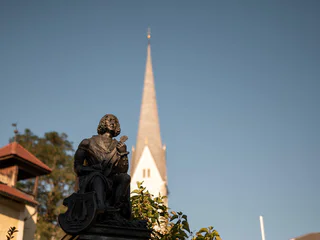
Lago Santo
Gfrill/Cauria, Salorno/Salurn, Alto Adige Wine Road
Jižní Tyrolsko je obzvláště bohaté na příběhy, které se vinou kolem tajných míst a neobvyklých přírodních útvarů. Památky, jako jsou čarodějnické lavice na Alpe di Siusi/Seiser Alm, vyprávějí příběhy o čarodějnicích a králích, zatímco místa síly, jako je "Stoanerne Mandln" s více než stovkou cairnů nebo starobylé zříceniny na kopci Castelfeder, vybízejí návštěvníky k odpočinku a hlubokému nádechu. Jedinečné přírodní útvary, jako jsou zemní pyramidy, jsou místa, která stojí za procházku a prozkoumání.

Gfrill/Cauria, Salorno/Salurn, Alto Adige Wine Road

La Costa/Seit, Laives/Leifers, Bolzano/Bozen and environs

1/3
Laces/Latsch, Latsch/Laces, Vinschgau/Val Venosta

Tesido/Taisten, Welsberg-Taisten/Monguelfo-Tesido

1/2
Bressanone città/Brixen Stadt, Brixen/Bressanone, Brixen/Bressanone and environs

1/2
Terento/Terenten, Terenten/Terento, Brixen/Bressanone and environs

1/8
Lasa/Laas, Laas/Lasa, Vinschgau/Val Venosta

Fleres/Pflersch, Brenner/Brennero, Sterzing/Vipiteno and environs

1/3
Anterselva di Mezzo/Antholz-Mittertal, Rasen-Antholz/Rasun Anterselva, Dolomites Region Kronplatz/Plan de Corones

Mazzon/Mazon, Neumarkt/Egna, Alto Adige Wine Road

1/3
Velloi/Vellau, Algund/Lagundo, Meran/Merano and environs

1/6
S.Cristina Gherdëina/S.Cristina Val Gardena/S.Cristina Gherdëina/St.Christina in Gröden, S.Crestina Gherdëina/Santa Cristina Val Gardana, Dolomites Region Val Gardena

Pavicolo/Pawigl, Lana, Meran/Merano and environs

1/2
Valdurna/Durnholz, Klausen/Chiusa, Brixen/Bressanone and environs

1/2
Valdaora di Sopra/Oberolang, Olang/Valdaora, Dolomites Region Kronplatz/Plan de Corones

1/3
Pinzano/Pinzon, Auer/Ora, Alto Adige Wine Road

1/2
Bressanone città/Brixen Stadt, Brixen/Bressanone, Brixen/Bressanone and environs

1/4
Issengo/Issing, Pfalzen/Falzes, Dolomites Region Kronplatz/Plan de Corones

1/4
Vernago/Vernagt, Schnals/Senales, Vinschgau/Val Venosta

1/3
Vallelunga/Langtaufers, Graun im Vinschgau/Curon Venosta, Vinschgau/Val Venosta

1/9
Casteldarne/Ehrenburg, Kiens/Chienes, Dolomites Region Kronplatz/Plan de Corones

1/5
Collepietra/Steinegg, Karneid/Cornedo all'Isarco, Dolomites Region Eggental

1/2
S.Cristina Gherdëina/S.Cristina Val Gardena/S.Cristina Gherdëina/St.Christina in Gröden, S.Crestina Gherdëina/Santa Cristina Val Gardana, Dolomites Region Val Gardena

Vilpiano/Vilpian, Terlan/Terlano, Alto Adige Wine Road

Tubre/Taufers i. M., Taufers im Münstertal/Tubre, Vinschgau/Val Venosta

1/4
Monguelfo/Welsberg, Welsberg-Taisten/Monguelfo-Tesido

1/2
Sluderno/Schluderns, Schluderns/Sluderno, Vinschgau/Val Venosta

1/7
Nova Levante/Welschnofen, Welschnofen/Nova Levante, Dolomites Region Eggental

Ora/Auer, Auer/Ora, Alto Adige Wine Road

1/2
Predonico/Perdonig, Eppan an der Weinstaße/Appiano sulla Strada del Vino, Alto Adige Wine Road